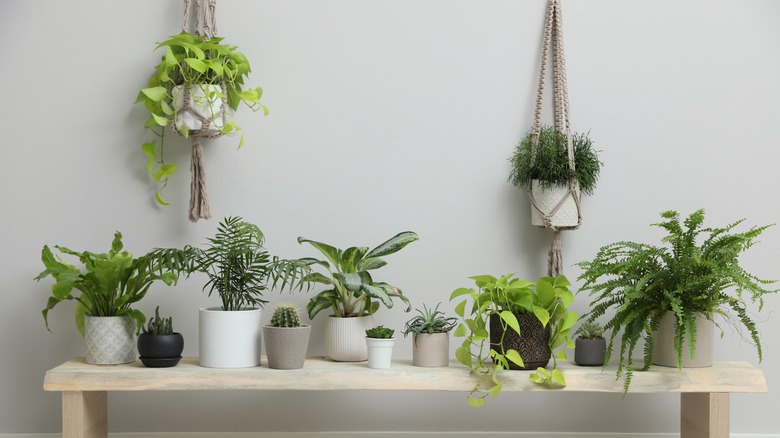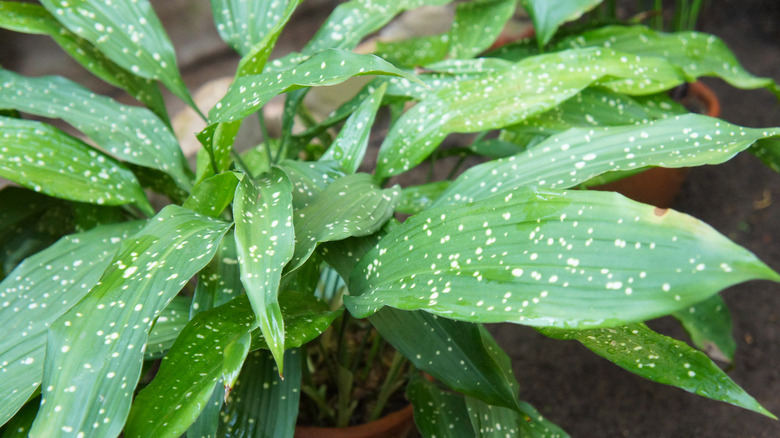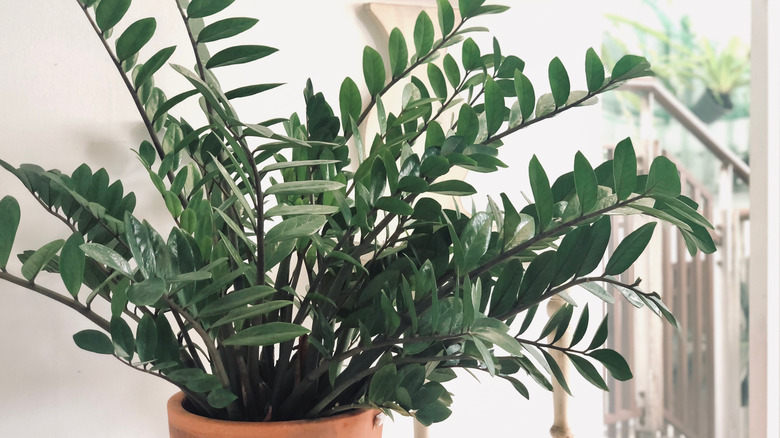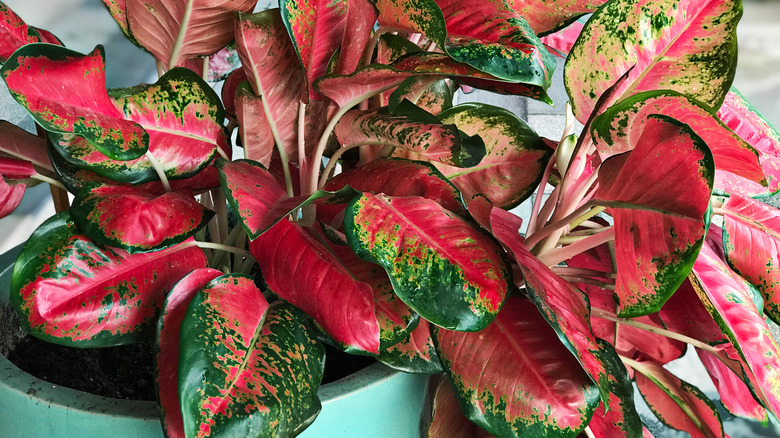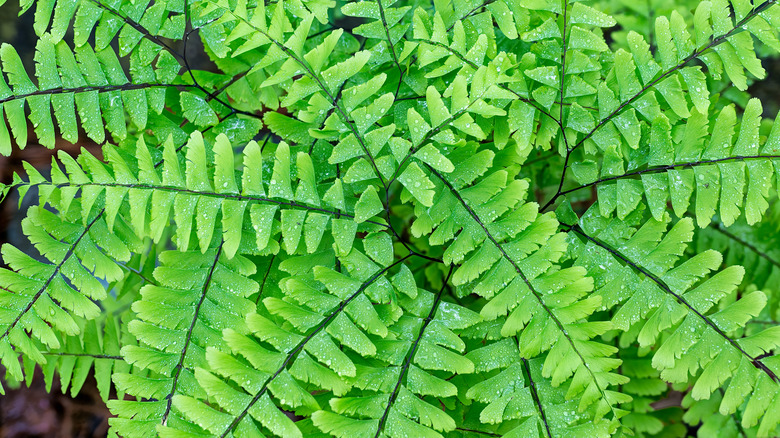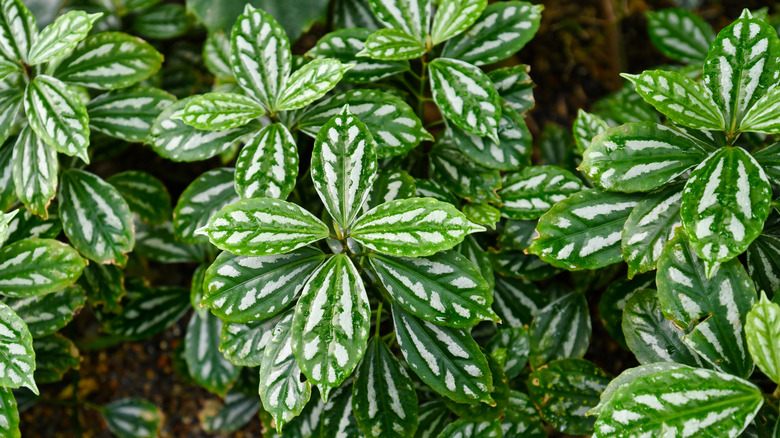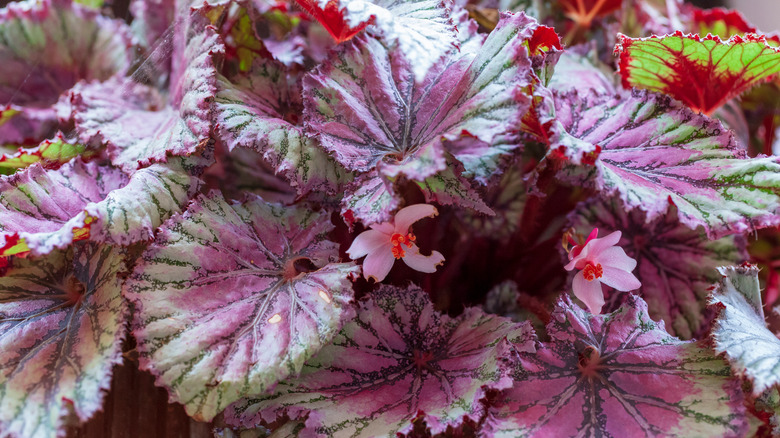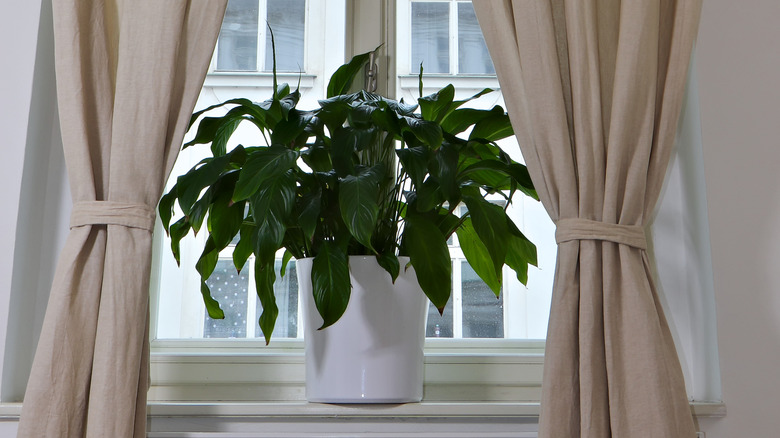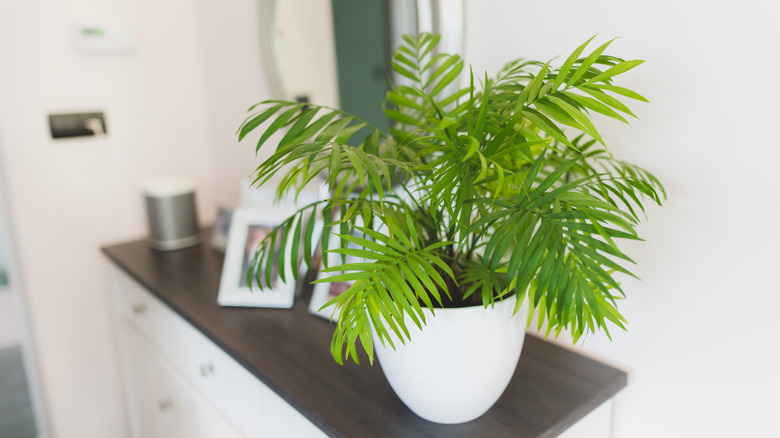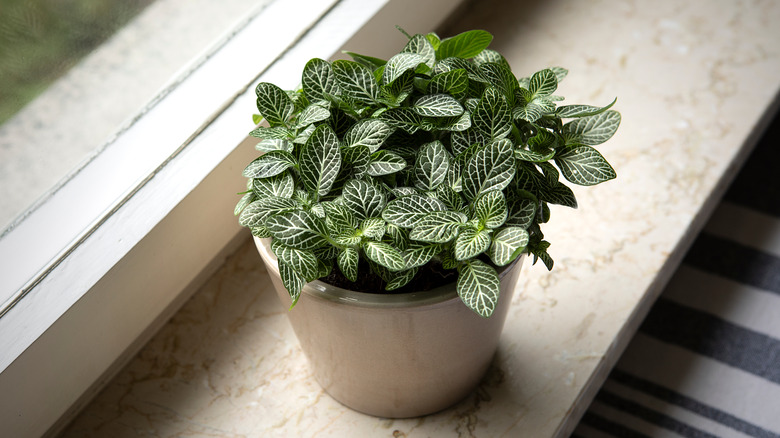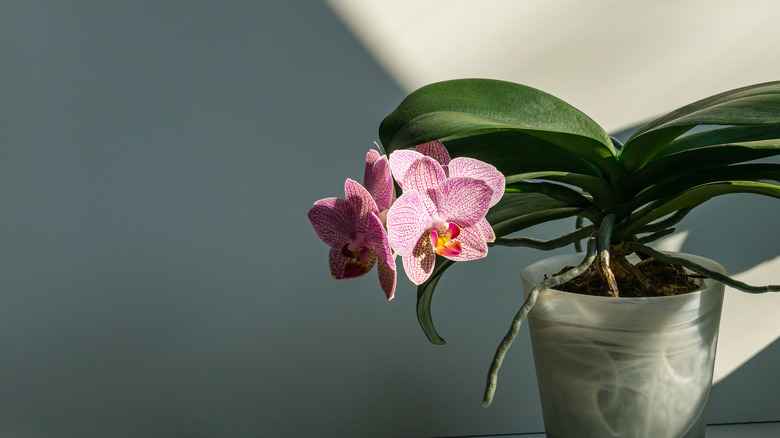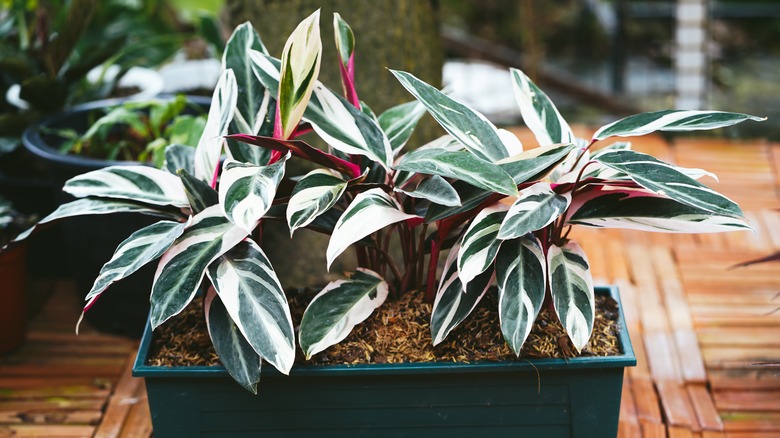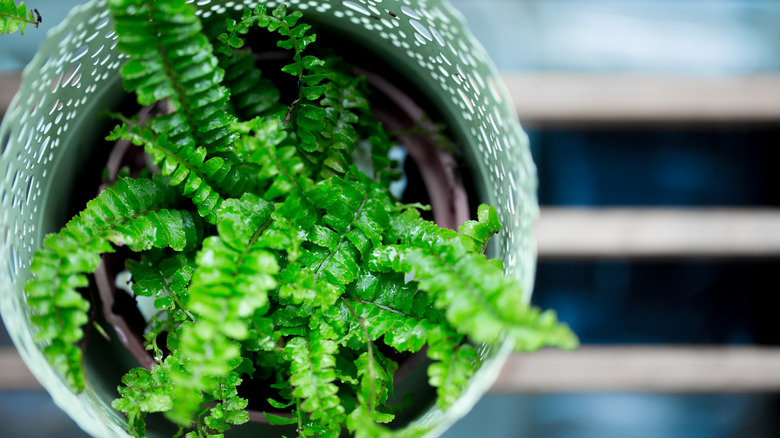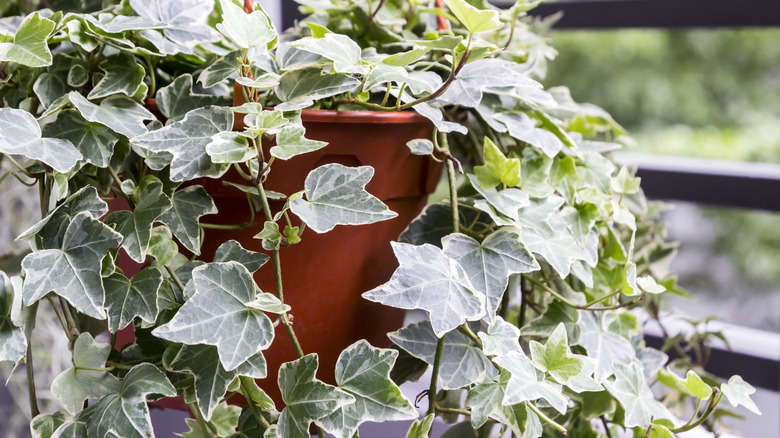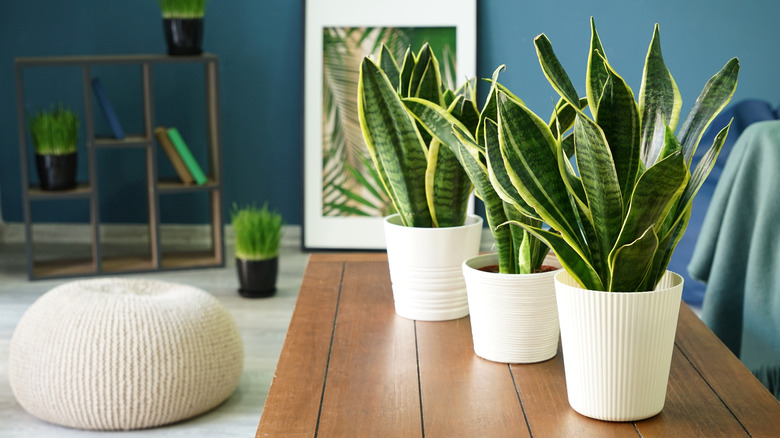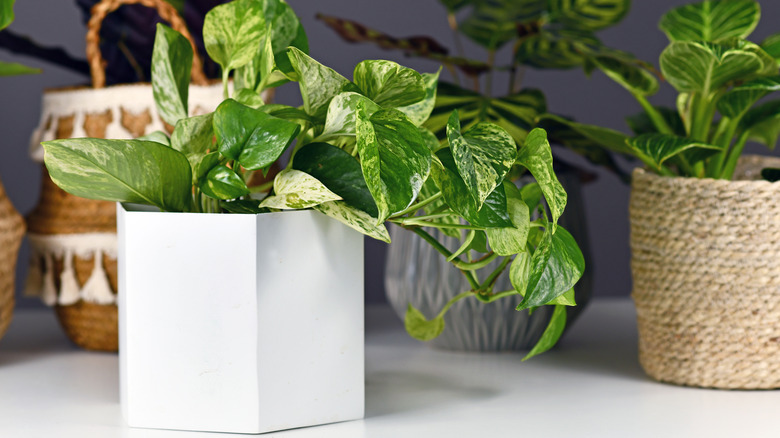15 Plants Perfect For A North-Facing Window
North-facing windows can be difficult to style with houseplants. Many of our favorite houseplants such as cacti, succulents, citrus plants, and rhododendron species prefer direct sunlight that only south or southwest-facing windows can provide. When plants such as these are only given low light they can lose their leaves, become leggy, or die. Don't fret. There is a heaping handful of other low-light-loving plants that are ready to dress up your dim, north-facing window.
Per the University of Minnesota Extension, nearly all plants that grow well in low light conditions are understory plants in their native environments. This means that they grow beneath taller plants that shade them from the sun. These species, which require small amounts or no direct light, typically grow slowly and won't need much water. Because of this, it will take some time before the north side of your home looks lush and green, yet, the plants you grow will be much more tolerant of neglect.
Cast iron plant
The cast iron plant (aspidistra elatior) is a low-maintenance plant that thrives in a variety of conditions. As per Missouri Botanical Garden, this herbaceous perennial in the asparagaceae family is known for its green, glossy leaves that arch outward. The large leaves look their best when they are wiped down on a regular basis.
Bloom Season: Spring, but rarely flowers indoors
USDA Growing Zone: 8 to 10
Growing Conditions: Bright, medium, or low indirect light
Soil Type: Well-drained, peaty potting mix
Size: 3 feet tall and 2 feet wide
ZZ plant
The ZZ plant (zamioculcas zamiifolia) is also sometimes called the aroid palm or the cardboard palm, explains the University of Florida. The plant can be identified by its upright, fleshy stems and its green ovate leaves. ZZ plants are quite drought-tolerant, and they will continue to grow in poor lighting.
Bloom Season: Mid-summer to fall
USDA Growing Zone:9 to 10
Growing Conditions: Medium to low indirect light
Soil Type: Well-drained potting mix
Size: 16 to 30 inches tall and 20 to 40 inches wide
Chinese evergreen
Chinese evergreens (aglaonema modestum) are herbaceous perennials that do well as houseplants. Native to the Philippines and Malaysia, the plant prefers temperatures above 70 degrees Fahrenheit, as told by North Carolina State Extension. If you have the space to support this plant, it will reward you with lush green or variegated foliage.
Bloom Season: Summer
USDA Growing Zone: 10 to 11
Growing Conditions: Medium to low indirect light
Soil Type: Well-drained potting mix
Size: 1 to 3 feet tall and 2 to 4 feet wide
Maidenhair fern
The maidenhair fern (adiantum pedatum) is characterized by arching fronds of light-green foliage that make the plant appear to be floating, explains Prairie Nursery. Though this plant does great outdoors, you can bring it inside to show off its lush green texture next to other houseplants. It looks best in a hanging planter in a north-facing window.
Bloom Season: Summer
USDA Growing Zone: 3 to 8
Growing Conditions: Medium to low indirect light
Soil Type: Well-drained potting mix
Size: 1 to 2 feet tall
Aluminum plant
The aluminum plant (pilea cadierei) gets its name from its leaves which are streaked with silver as if they were painted with aluminum, as explained by Missouri Botanical Garden. Over time, a young plant will become bushy and lose some of its unique colors. For this reason, some houseplant owners will replace their aluminum plants every year.
Bloom Season: Rarely flowers indoors
USDA Growing Zone: 11 to 12
Growing Conditions: Bright, medium, or low indirect light
Soil Type: Well-drained, peaty, soil-based potting mix
Size: 9 to 12 inches tall and 6 to 9 inches wide
Painted-leaf begonia
Painted-leaf begonias (begonia rex-cultorum) are one of the few begonia family members that are not grown for their flowers. Even though they do blossom with small flowers, as per the University of Connecticut, people prefer their unique, multi-colored leaves. Keep in mind the leaves of a rex begonia vary greatly between cultivars.
Bloom Season: Summer
USDA Growing Zone: 10 to 12
Growing Conditions: Bright, medium, or low indirect light
Soil Type: Average potting mix
Size: 12 to 18 inches tall and wide
Peace Lily
As noted by Clemson Cooperative Extension, there are more than 40 distinct species of peace lilies (spathiphyllum spp.) and many more hybrid cultivars. Despite this, nearly all peace lily varieties have the same care requirements. They enjoy indirect light, warm weather conditions, and well-drained soil.
Bloom Season: Spring
USDA Growing Zone: 10 to 11
Growing Conditions: Bright, medium, or low indirect light
Soil Type: Well-drained potting mix
Size: 1 to 6 feet tall
Bamboo palm
Bamboo palms (chamaedorea elegans), which are also referred to as parlor palms, dwarf palms, and miniature fishtail dwarf palms, can grow up to 7 feet tall indoors. According to North Carolina State Extension, they are well-known for their arching fronds and their erect growth habit.
Bloom Season: Spring to fall
USDA Growing Zone: 10 to 12
Growing Conditions: Bright, medium, or low indirect light
Soil Type: Well-drained potting mix with high organic matter
Size: 2 to 7 feet tall and 2 to 3 feet wide
Nerve plant
Nerve plants (fittonia albivenis) or mosaic plants, can be recognized by their ovate leaves that are lined with red, pink, or white veins depending on the cultivar. This species appreciates high humidity and frequent watering. With proper care, this herbaceous perennial can grow up to 6 inches tall, says Missouri Botanical Garden.
Bloom Season: Summer
USDA Growing Zone: 11 to 12
Growing Conditions: Bright, medium, or low indirect light
Soil Type: Well-drained peaty or soil-based potting mix
Size: 6 inches tall and 1-foot wide
Moth orchid
Moth orchids (phalaenopsis spp.) are common houseplants that do well in a variety of growing conditions including low light. A north-facing window can provide them with enough light to bloom. As mentioned by the University of Maryland Extension, moth orchids should be kept moist by a humidifier and watered once per week.
Bloom Season: Winter to spring
USDA Growing Zone: 11 to 12
Growing Conditions: Bright, medium, or low indirect light
Soil Type: Loose bark or another loose potting medium
Size: No larger than 3 ft tall
Never-Never plant
The never-never plant (ctenanthe oppenheimiana) is an evergreen perennial that enjoys the partial shade that a north-facing window can provide. This plant in the ctenanthe genus has long, ovate leaves that may be green or variegated depending on the cultivar, as shown by RHS.
Bloom Season: Spring to fall
USDA Growing Zone: 10 to 11
Growing Conditions: Medium to low indirect light
Soil Type: Well-drained potting mix
Size: 20 inches to 40 inches tall and wide
Boston Fern
Per the University of Wisconsin-Madison, Boston ferns (nephrolepis exaltata 'Bostoniensis') have trouble growing in weather that is too hot or too cold. This makes them a perfect option for a houseplant. In hanging baskets, Boston ferns will flourish when kept in a window with medium light such as a north-facing window.
Bloom Season: Does not flower
USDA Growing Zone: 9 to 11
Growing Conditions: Bright, medium, or low indirect light
Soil Type: Well-drained, rich potting mix
Size: Up to 7 feet tall
English ivy
English ivy (hedera helix) can be a wonderful houseplant as long as you don't have any pets or children in your household. The gorgeous leaves and stems contain toxic compounds which can lead to a range of problems if consumed or touched, warns North Carolina State Extension. Still, when properly handled, English ivy looks great cascading from a pot on a high shelf.
Bloom Season: Fall and summer
USDA Growing Zone: 4 to 12
Growing Conditions: Bright, medium, or low indirect light
Soil Type: Well-drained potting mix
Size: Grows up to 80 feet long outdoors
Snake plant
The snake plant (sansevieria trifasciata) is a species with many cultivars that boast gorgeous variegation and a range in height. As pointed out by Penn State Extension, this succulent houseplant is very low-maintenance, and it tolerates all kinds of lighting.
Bloom Season: Spring
USDA Growing Zone: 9 to 11
Growing Conditions: Bright, medium, or low indirect light
Soil Type: Well-drained potting mix
Size: 6 inches to 3 feet tall depending on the variety
Golden pothos plant
Golden pothos plants (epipremnum aureum) are known for being easy to propagate, grow, and care for. The only problems you'll need to watch out for when nurturing a golden pothos plant are pests, harsh sunlight, and symptoms of overwatering, as told by The Sill.
Bloom Season: Does not flower
USDA Growing Zone: 10 to 12
Growing Conditions: Bright, medium, or low indirect light
Soil Type: Well-draining potting mix
Size: 6 to 10 feet when grown indoors
